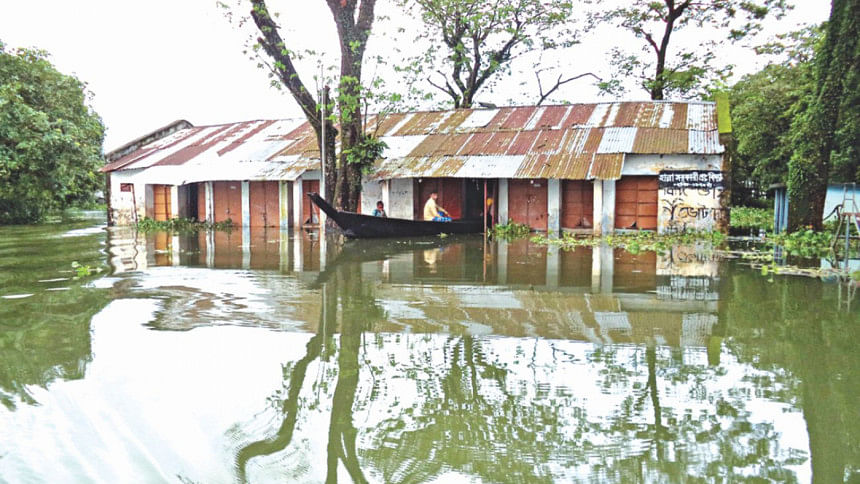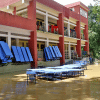All rivers overflowing

The flooding in Sylhet might take an alarming turn and trigger landslides in the hilly areas as heavy rain is expected to continue in the district till Friday.
More than one lakh people have been marooned in several upazilas as downpours and onrush of water from the upstream inundated vast swathes of land.
In Moulvibazar, the overall flood situation remained unchanged yesterday as houses, schools and roads went under water.
According to Water Development Board (WDB) and the meteorological department in Sylhet, heavy rain in the Barak basin across the border was responsible for the flood.
Rain water from upstream was causing the Surma and the Kushiara rivers spill over their banks at some points, damaging dykes.
In Sylhet's Amalshid, where the Barak bifurcates to form the Surma and the Kushiara, water was flowing to 85 cm above the danger level on Sunday night.
The Kushiara was flowing 73 cm above the danger level at Shewla point and 24 cm at Sherpur point. The Surma was flowing 56 cm above the danger level at Kanaighat point.
The two rising rivers inundated several hundred villages in Zakiganj, Kanaighat, Fenchuganj, Beanibazar, Golapganj and Osmaninagar upazilas in the last seven days. Besides, Goainghat and Companiganj upazilas were hit by flash floods due to the onrush of water from the hills of Meghalaya.
Some areas in Sylhet Sadar upazila also went under water, but the situation was not as grave as in some other upazilas.
Sirajul Islam, executive engineer of WDB in Sylhet, said flood water might continue to rise for some more days due to heavy rain in the Barak basin.
Syed Ahmed Chowdhury, a Met official of Sylhet meteorological department, said the district might experience heavy rain till Friday and the flooding might take an alarming turn and cause landslides in hilly areas.
Earlier this year, Sylhet suffered a huge loss as the Boro crop was damaged due to flash floods in haor areas. The district is now faced with another loss as the Aush paddy on around 3,000 hectares of land has been inundated, said district administration officials.
At least 161 primary and 13 higher secondary schools were shut. Around 100 flood-hit families took shelter at nine shelter centres opened by the district administration.
Rahat Anwar, deputy commissioner of Sylhet, said the administration was considering the situation as a natural disaster.
A total of 128 tonnes of rice was distributed in six upazilas and Tk 2.77 was given to flood-hit families as part of the government's relief initiative, he said, adding medical teams were formed in each upazila to monitor the health condition of the victims, especially the children.
MOULVIBAZAR
The flood submerged 29 unions in the district's three upazilas.
“We've been confined to our house since the Eid day [June 26] when water entered the home,” said Husna Begum, 36-year-old housewife from Bhuksimul area of Kulaura.
Misbah Uddin, 45, of the same area said locals couldn't cook food in their houses for the last couple of days as those went under water.
Like in Sylhet, Moulvibazar also saw a similar calamity in March when the Sonai, Kontinala, Juri and Kushiara rivers swelled, causing flash floods in the district. Farmers incurred a huge loss due to the damage of Boro crops.
The latest flood has come as another blow to the growers as their seedbeds of Aus and Aman crops have already been inundated.
The government disbursed relief materials to the affected people through various disaster management programmes, but the allocation was still inadequate, said Borolekha UNO SM Abdullah Al Mamun.
AFM Kamrul Islam, chairman of Kulaura Upazila Parishad, called upon the government to declare the region as a disaster area and take immediate steps to alleviate the sufferings of the flood victims.
Abdul Alim, primary education officer in Moulvibazar, said 152 primary schools were closed in the district.
Forty-eight secondary schools were shut and eight of them were being used as flood shelters, said ASM Abdul Wadud, district education officer of Moulvibazar.


 For all latest news, follow The Daily Star's Google News channel.
For all latest news, follow The Daily Star's Google News channel. 








Comments